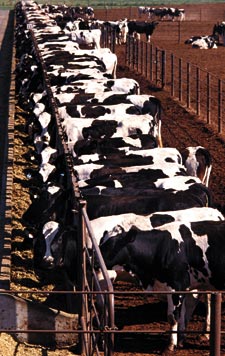Beef Producers Brace For BSE Fallout

Following weeks of record-high cattle prices, beef producers continue to suffer from the fallout from a positive case of bovine spongiform encephalopathy (BSE), also known as Mad Cow Disease, confirmed in the state of Washington, Dec. 22.”The beef futures market showed a drop almost immediately when the BSE case was announced,” said Alabama Farmers Federation Beef Director Perry Mobley. “The good news is that most cattle markets were closed for the holidays when the case was first announced. That time period provided an opportunity for beef producers to make plans regarding their marketing strategies. However, when the markets reopened, prices did drop, mostly as a result from bans on imports of American beef in more than two dozen countries.”Japan, the largest market for American beef, was among the first to suspend imports after the BSE case was confirmed. Japan purchased more than $1 billion in American beef last year.Gregg Doud, an economist for the Denver-based National Cattlemen’s Beef Association, said the United States, at market level, stands to lose at least $2.6 billion a year in exports and falling domestic prices because of the BSE case. In the three days following the announcement of the positive BSE case, the United States lost roughly 90 percent of its export market, Doud said in late December.However, trackers with the Chicago Mercantile Exchange just one week after the BSE case was confirmed said they were encouraged by signs that U.S. consumers were sticking with beef despite the scare. Major hamburger chains like McDonald’s Corp., Burger King and Wendy’s said the scare had little effect on sales.A delegation from the U.S. Department of Agriculture led by David Hegwood, a trade advisor to U.S. Agriculture Secretary Ann Veneman, met with Japanese officials in Tokyo shortly after the BSE case was discovered, trying to re-establish the market.The USDA’s chief veterinary officer, Dr. Ron DeHaven, said any trade ban on American beef “should be well-founded on science.” He noted that science shows certain meat cuts are safe from infection. Ground beef from labeled cuts like chuck or round, as well as beef steaks, roast, liver and tongue, are considered safe, experts say.Alfa Farmers President Jerry Newby said he is confident in the safety of America’s food supply.”There is no reason to believe that any harmful or infected products from this animal made it to the retail level,” Newby said. “The Alabama Farmers Federation is working with the state veterinarian and USDA to assess the effect this situation will have on Alabama producers. In the coming weeks, we also will look for ways to lessen the economic impact resulting from lost export markets.”Newby added that consumers should continue to have faith that America has the safest food supply in the world. The preliminary diagnosis of this isolated case of BSE is evidence that the thorough food safety measures put in place by USDA and the beef industry are working, he said.According to the most recent data collected by the National Agricultural Statistic Service, there are 1.44 million head of cattle and calves on Alabama farms, with an estimated worth of nearly a billion dollars prior to the market drop.U.S. and Canadian officials have been pressing international regulators at the World Organization for Animal Health, or OIE, to change their policies so beef and cattle trade would continue if a country suffers a single case of illness but does not have a widespread outbreak. Currently, the organization recommends countries shut down their borders to beef trade with any nation where BSE is found.USDA continues to work with Canadian officials to verify traceback of the cow identified with BSE. Records obtained from the owner correspond with Canada’s records indicating that this animal was approximately 6-1/2 years old at the time of slaughter. USDA is working with Canada to conduct DNA testing to verify that the correct animal has been identified.The age of the animal is significant because she would have been born before feed bans were implemented in North America in August 1997. The feed bans prohibit the inclusion of ruminant protein in feed intended for other ruminants to eat. That practice has been identified as the primary means by which BSE is spread. When a single case of BSE was confirmed earlier this year in Canada, it took about three months before the United States began relaxing a near-total ban on Canadian beef. That came after U.S. teams took a close look at Canadian safeguards in response to the BSE finding in Alberta.USDA ordered a recall of more than 10,000 pounds of meat from 20 cows slaughtered on the same day at the same Washington state company. The recalled meat was distributed to eight states and Guam, although officials said 80 percent of it went to Oregon and Washington.USDA officials have said they ordered the recall as a precaution, insisting there was no threat to the safety of the U.S. food supply.One week following the confirmation of the BSE case, the USDA strengthened regulations regarding beef slaughter and handling. All downer (non-ambulatory) cattle are now banned from the human food chain, and all meat from suspect cattle will be held until it tests negative for BSE. USDA also has barred “specified risk materials” such as the skull, brain, trigeminal ganglia, eyes, vertebral column, and spinal cord and dorsal root ganglia of cattle over 30 months of age and the small intestine of cattle of all ages from the human food supply–even though packers typically don’t use these parts in food.The new regulations also banned air-injection stunning of cattle at slaughter facilities and increased restrictions on mechanically separated meat for human consumption.
